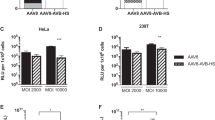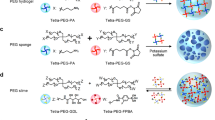Abstract
Adeno-associated viral (AAV) vectors, which are undergoing broad exploration in clinical trials, have significant promise for therapeutic gene delivery because of their safety and delivery efficiency. Gene delivery technologies capable of mediating localized gene expression may further enhance the potential of AAV in a variety of therapeutic applications by reducing spread outside a target region, which may thereby reduce off-target side effects. We have genetically engineered an AAV variant capable of binding to surfaces with high affinity through a hexa-histidine metal-binding interaction. This immobilized AAV vector system mediates high-efficiency delivery to cells that contact the surface and thus may have promise for localized gene delivery, which may aid numerous applications of AAV delivery to gene therapy.
This is a preview of subscription content, access via your institution
Access options
Subscribe to this journal
Receive 12 print issues and online access
$259.00 per year
only $21.58 per issue
Buy this article
- Purchase on Springer Link
- Instant access to full article PDF
Prices may be subject to local taxes which are calculated during checkout




Similar content being viewed by others
References
Fisher KJ, Jooss K, Alston J, Yang Y, Haecker SE, High K et al. Recombinant adeno-associated virus for muscle directed gene therapy. Nat Med 1997; 3: 306–312.
Kaplitt MG, Leone P, Samulski RJ, Xiao X, Pfaff DW, O’Malley KL et al. Long-term gene expression and phenotypic correction using adeno-associated virus vectors in the mammalian brain. Nat Genet 1994; 8: 148–154.
Flannery JG, Zolotukhin S, Vaquero MI, LaVail MM, Muzyczka N, Hauswirth WW . Efficient photoreceptor-targeted gene expression in vivo by recombinant adeno-associated virus. Proc Natl Acad Sci USA 1997; 94: 6916–6921.
Maguire AM, Simonelli F, Pierce EA, Pugh Jr EN, Mingozzi F, Bennicelli J et al. Safety and efficacy of gene transfer for Leber's congenital amaurosis. N Engl J Med 2008; 358: 2240–2248.
Bainbridge JW, Smith AJ, Barker SS, Robbie S, Henderson R, Balaggan K et al. Effect of gene therapy on visual function in Leber's congenital amaurosis. N Engl J Med 2008; 358: 2231–2239.
Selkirk SM . Gene therapy in clinical medicine. Postgrad Med J 2004; 80: 560–570.
Hu WW, Wang Z, Hollister SJ, Krebsbach PH . Localized viral vector delivery to enhance in situ regenerative gene therapy. Gene Ther 2007; 14: 891–901.
Stachelek SJ, Song C, Alferiev I, Defelice S, Cui X, Connolly JM et al. Localized gene delivery using antibody tethered adenovirus from polyurethane heart valve cusps and intra-aortic implants. Gene Ther 2004; 11: 15–24.
Jang JH, Houchin TL, Shea LD . Gene delivery from polymer scaffolds for tissue engineering. Expert Rev Med Devices 2004; 1: 127–138.
Mizuguchi H, Hayakawa T . Targeted adenovirus vectors. Hum Gene Ther 2004; 15: 1034–1044.
Barnett BG, Crews CJ, Douglas JT . Targeted adenoviral vectors. Biochim Biophys Acta 2002; 1575: 1–14.
Jang JH, Bengali Z, Houchin TL, Shea LD . Surface adsorption of DNA to tissue engineering scaffolds for efficient gene delivery. J Biomed Mater Res A 2006; 77: 50–58.
Lei P, Padmashali RM, Andreadis ST . Cell-controlled and spatially arrayed gene delivery from fibrin hydrogels. Biomaterials 2009; 30: 3790–3799.
Yue TW, Chien WC, Tseng SJ, Tang SC . EDC/NHS-mediated heparinization of small intestinal submucosa for recombinant adeno-associated virus serotype 2 binding and transduction. Biomaterials 2007; 28: 2350–2357.
Fishbein I, Alferiev IS, Nyanguile O, Gaster R, Vohs JM, Wong GS et al. Bisphosphonate-mediated gene vector delivery from the metal surfaces of stents. Proc Natl Acad Sci USA 2006; 103: 159–164.
Mei L, Jin X, Song C, Wang M, Levy RJ . Immobilization of gene vectors on polyurethane surfaces using a monoclonal antibody for localized gene delivery. J Gene Med 2006; 8: 690–698.
Koerber JT, Jang JH, Yu JH, Kane RS, Schaffer DV . Engineering adeno-associated virus for one-step purification via immobilized metal affinity chromatography. Hum Gene Ther 2007; 18: 367–378.
Arnold GS, Sasser AK, Stachler MD, Bartlett JS . Metabolic biotinylation provides a unique platform for the purification and targeting of multiple AAV vector serotypes. Mol Ther 2006; 14: 97–106.
Duan D, Yue Y, Yan Z, Yang J, Engelhardt JF . Endosomal processing limits gene transfer to polarized airway epithelia by adeno-associated virus. J Clin Invest 2000; 105: 1573–1587.
Summerford C, Samulski RJ . Membrane-associated heparan sulfate proteoglycan is a receptor for adeno-associated virus type 2 virions. J Virol 1998; 72: 1438–1445.
Girod A, Ried M, Wobus C, Lahm H, Leike K, Kleinschmidt J et al. Genetic capsid modifications allow efficient re-targeting of adeno-associated virus type 2. Nat Med 1999; 5: 1052–1056.
Koerber JT, Maheshri N, Kaspar BK, Schaffer DV . Construction of diverse adeno-associated viral libraries for directed evolution of enhanced gene delivery vehicles. Nat Protoc 2006; 1: 701–706.
Maheshri N, Koerber JT, Kaspar BK, Schaffer DV . Directed evolution of adeno-associated virus yields enhanced gene delivery vectors. Nat Biotechnol 2006; 24: 198–204.
Acknowledgements
This work was supported by NIH R01HL081527. In addition, JJ was supported by a grant from the California Institute for Regenerative Medicine (Training Grant Number T1-00007). The contents of this publication are solely the responsibility of the authors and do not necessarily represent the official views of CIRM or any other agency of the State of California.
Author information
Authors and Affiliations
Corresponding author
Ethics declarations
Competing interests
The authors declare no conflict of interest.
Rights and permissions
About this article
Cite this article
Jang, JH., Koerber, J., Gujraty, K. et al. Surface immobilization of hexa-histidine-tagged adeno-associated viral vectors for localized gene delivery. Gene Ther 17, 1384–1389 (2010). https://doi.org/10.1038/gt.2010.81
Received:
Revised:
Accepted:
Published:
Issue Date:
DOI: https://doi.org/10.1038/gt.2010.81
Keywords
This article is cited by
-
Safety and efficacy evaluations of an adeno-associated virus variant for preparing IL10-secreting human neural stem cell-based therapeutics
Gene Therapy (2019)
-
A survey of ex vivo/in vitro transduction efficiency of mammalian primary cells and cell lines with Nine natural adeno-associated virus (AAV1-9) and one engineered adeno-associated virus serotype
Virology Journal (2013)
-
Elastin-like polypeptide matrices for enhancing adeno-associated virus-mediated gene delivery to human neural stem cells
Gene Therapy (2012)
-
Engineering Biomaterial Systems to Enhance Viral Vector Gene Delivery
Molecular Therapy (2011)



